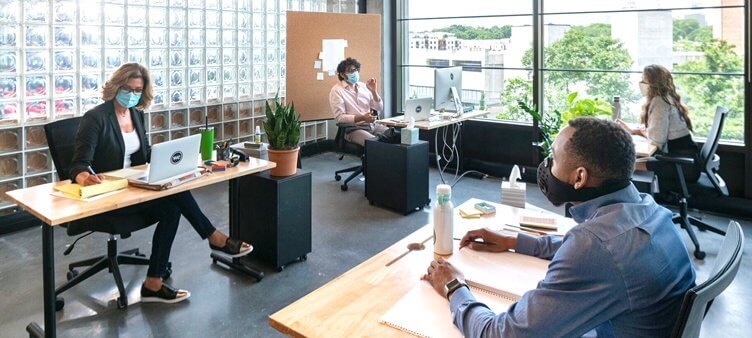
2020 has been a tumultuous year. However, it’s nearly over now, and with the vaccine being dished out across the UK and other parts of the world, everyone’s hopeful that the end is now in sight and we can start going back to life as we once knew it.
Despite the vaccine and the hope that it brings, it’s still just as important as ever to stay alert, remain cautious, and make conscious efforts to limit the spread of COVID-19.
One area where this is perhaps more important than any other is the workplace. With many people now off furlough and back in the office and other workplaces, lots of different households will be sharing the same spaces as they go about their day-to-day jobs. To prevent a flare-up in infections and keep the infection rate down, both employers and employees need to take steps to control and mitigate transmission—by becoming ‘COVID-secure’.
According to the Health and Safety Executive (HSE), “COVID-secure” means that “businesses need to put in place workplace adjustments to manage the risk of coronavirus and protect their workers and others from coronavirus”. Businesses have been provided with practical steps in order to do this.
These include:
All businesses should already have risk assessments laid out; they’re standard practice. This means that for the most part, they simply need to be updated to account for COVID-19 and the risk that comes with it to their premises, staff, and wider business.
Updating risk assessments to account for COVID-19 will help paint a clearer picture and aid managers in their understanding of what needs to be done to protect their staff. A risk assessment should:
Employers are required by law to take reasonable steps to protect their workers from COVID-19. And because the virus can transfer from people to surfaces and surfaces to people, it’s therefore imperative that workplaces are kept clean and sanitised at all times. This means that many businesses will need to thoroughly revise their hygiene procedures and carry out more frequent cleaning.
The most important thing you can do as an employee or workspace manager is to promote regular handwashing and hand sanitising. This can be done through official company policies, signs, posters, and educational material. It also helps if there are plenty of opportunities for workers to actually wash hands; they’re far more likely to do it if they can access facilities easily.
At the same time, we know that the reality is that most businesses aren’t able to start installing new sinks and handwashing Hand sanitiser stations. This is where sanitiser dispenser and hand sanitiser dispensers come in. You can learn more about these below:
The best way to fight the virus is to stay at home. If we’re not coming into contact with other people and surfaces, it’s not going to be able to spread as effectively. This is exactly why the government has encouraged businesses to enable home working wherever possible. And indeed, wherever possible, you should be facilitating this.
Unless it’s absolutely imperative that your employees work from your office or workspace, you should allow them to work from home and provide the equipment necessary to do this, such as computers, phones, and videoconferencing facilities.
The Health and Safety Executive’s website provides further guidance on supporting employees as they work from home.
Social distancing works: the coronavirus’s efficacy is drastically reduced when people are two metres or more apart. In your workspace, consider enforcing social distancing by:
Even with all the precautions in the world taken by employers, it’s still important for everybody using an office, and indeed any other workspace, to take responsibility for themselves and others.
Here are six ways you can do this:
As you’ll be well aware by this point, it’s imperative that you wash your hands regularly and thoroughly. This is especially true if you’ve been handling items like shared coffee pots, printers, and telephones, or if you’ve been in spaces like shared meeting rooms and kitchenettes. In fact, any time you touch something that somebody else has—e.g., a door handle, a button in a lift, or a light switch—you should wash your hands with soap and water.
This is because all of these things can provide a home to a myriad of disease-causing pathogens and germs, including those which cause COVID-19.
To stop yourself from getting sick, it’s important to wash your hands often. When you do, wash for at least 20 seconds with soap and warm water, especially after going to the bathroom, before eating, or after coughing and sneezing.
If it’s not easy for you to access soap and water at your workplace, keep a bottle of hand sanitiser close by. Preferably, you should use Hand Sanitizer Dispenser that has at least 60 per cent alcohol content to best protect yourself from germs.
Using hand sanitiser is a quick and easy way to disinfect your hands in between washing with soap and water. Remember, though, that hand sanitiser is a superficial clean; it doesn’t remove grime, dirt, and oil from your hands like soap and water does. If your hands are dirty, however, then make sure you wash them with soap and water because pathogens can ‘hide’ underneath this dirt even after sanitising.
Even better than a bottle of hand sanitiser at your desk are purpose-built desktop hand sanitiser dispensers. These sit discretely out of the way and give you easy access to hand sanitiser when you need it.
According to research, the average desk has a whopping 800 bacteria… per square inch. That’s roughly 14 times as many bacteria than what is found on an average office toilet seat. It goes without saying, therefore, that to prevent yourself from getting sick, you should be cleaning your workspace often with disinfectant sprays and wipes.
When cleaning your workspace, pay particular attention to the items you touch most often, such as your keyboard, mouse, monitor buttons, and desk phone, as well as the desk surface.
The best way to protect yourself from illness and infections is to limit the amount of contact and exposure your hands have with surfaces. This is why gloves have become so popular, though we don’t recommend their use for day-to-day tasks.
Instead, try to make a habit of using a tissue when grabbing or touching surfaces that lots of other people will have touched, too, such as door handles and buttons.
We’ve all heard the saying by now—“hands, face, space,” and while it may be irritating to hear it on repeat, it’s a key piece of advice that you should be following.

Not touching your face is one of the easiest ways to prevent yourself from getting ill. Image used courtesy of Clarissa Leahy/Getty Images.
According to the World Health Organisation and the UK National Health Service, you should avoid touching your face at all costs to help prevent yourself from contracting illnesses like COVID-19. This is because if you have the virus on your hands, touching your face gives the virus a potential route into your body where it’ll be able to infect you.
Rather worryingly, however, people touch their faces an average of 24 times per hour according to a 2015 study, and roughly 44 per cent of that touching involves the eyes, nose, and mouth.
It’s also important to limit the amount of physical contact we have with one another. This includes hugging and handshaking, the former of which tends to happen a lot in business and work-related settings.
In fact, the handshake is so ingrained into our culture that it has been a tough action to stamp out, leading to many companies actively encouraging employees to abstain from doing it. Alternatives to handshakes include nodding, slight bowing, and even touching elbows. Anything that doesn’t involve the hands.
Hand hygiene is key to preventing the spread of coronavirus.
Coronaviruses are a group of contagious, flu-like viruses. They’re able to cause symptoms that are as mild and harmless as the common cold, but some symptoms can be fatal for the elderly or people with compromised immune systems. COVID-19 is the disease caused by a new type of coronavirus that has defined 2020 and continues to spread around the world.
And although we now have a vaccine, preventing the spread of COVID-19 from person-to-person is still important to reduce the virus’ impact and prevent unnecessary deaths. Preventing the spread also helps stop the healthcare system becoming overrun.
Frequent thorough handwashing with soap and water is one of the best ways to prevent the spread of infectious diseases like COVID-19. In fact, it’s the first line of defence against them.
Like a cold, coronaviruses are spread through droplets from a person coughing or sneezing, and potentially via contaminated surfaces. Although we can’t always stop ourselves coming into contact with contaminated surfaces, we can kill the virus by washing our hands after touching them.
Along with other important behaviours like physical distancing, isolating when you have symptoms or test positive, and thoroughly washing hands often and at key moments is essential to controlling the pandemic.
The U.S. Centers for Disease Control and Prevention (CDC) recommends the following simple approach, broken down into five parts:
1. Wet your hands;
2. Lather up with soap (any kind: bar or gel);
3. Rub your hands together for at least 20 seconds);
4. Rinse; and
5. Dry off with a clean towel, disposable paper towels, or a hand dryer.
It’s simple and quick—there’s no excuse for people to not be doing this regularly.
If you think you’ve touched a contaminated surface and you aren’t able to wash your hands with soap and water, the next best alternative is hand sanitiser.
Hand sanitiser is far more accessible and convenient than having to visit a sink each time you want to clean your hands, and it yields virtually the same results as hand washing so far as coronaviruses are concerned. They don’t kill all viruses though (i.e., norovirus), so it’s important to not use it for everything.
Hand sanitisers are clear liquids or gels that are rubbed into the hands to kill germs and bacteria. While there are many different hand sanitisers available on the market, they all do the same thing and have very similar ingredients.
The main difference between hand sanitisers is whether or not they contain alcohol or are alcohol-free. Some hand sanitisers brands may also come with extra ingredients such as fragrances or skin softeners. No matter what the brand, the basic ingredients of an alcohol-based or alcohol-free hand sanitiser will remain the same.
To find out more, read our complete guide to hand hygiene which covers everything you need to know about hand washing and hand sanitiser.
If you are responsible for an office or any other sort of workplace environment, it’s absolutely crucial that you follow the official COVID-19 guidance as issued by the governments and authorities such as the Public Health Authority and Health and Safety Executive.
A huge part of ensuring compliance is hand hygiene, and that’s why we provide a large range of hand hygiene products ideal for the workplace, no matter if it’s an office, shop, or restaurant.
Read our blog for more resources or visit our online shop.
Emir Limam – E11 Group B.V. Netherlands – Fraudster
24 May 2023When to Take a Test After Covid Exposure?
30 January 2023A Rapid Antigen Test vs a Lateral Flow Test for Covid-19
30 January 2023
February 3, 2021 at 12:01 am
[…] ‘COVID-Secure’ Workplaces and Advice for Employers […]